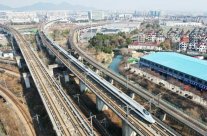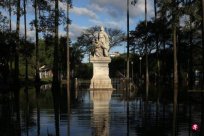
If you can keep these valuable resources and seek a certain degree of ecological reconstruction, it can form an effective buffer area for meteorological disasters such as floods and droughts.
The last survey in Brazil was 2018. It took two months to surround Geno Soybean Matugrosso, Argentina, Chile's planting, trade, ecological risks, and cultural losses in Brazil's largest production area.In the annual crown disease, it is difficult for Chinese colleagues to enter Brazil, mainly on field research by Brazilian colleagues.In 2024, the World Water Scenic Survey Team of the Nature Research Institute once again merged with Brazilian colleagues to conduct a one -month cross -regional survey.The research area revolves around Brazil's more unique ecological environment -the Atlantic Rainforest residual area, especially the Atlantic Rainforest with the island.
The Institute of Natural forces was initiated by several researchers graduated from Nanjing University, the School of Political Economics and Economics of London, and the University of Brazil.Discussion, consensus achievement, and solution study on the problem.
Unfortunately, every time there is a bad incident before and after the large Brazil survey: in 2018, before conducting South American surveys, our team carried out in Rio de Janeiro, St. Paul, Brazil, Basilia.Careful research and investigation, compare and integrate these museum data with field survey data -just one week after we visited the Brazil National Museum, a fire broke out on September 2, 2018.destroy.
In the whole process of our Latin America's genetically modified soybean planting survey, the data we mainly collect is to study genetically modified soybeans while bringing huge economic benefits, but in ecological diversity, cultural diversity, ethnic opposition, risk society, etc.The impact of the field.When we investigated in August 2018, we found that the soybean planting area was in multiple landforms, which in fact caused the destruction of forests and soil degradation. It was green during the planting period. However, during the harvest, the local ecological vision was like a desert. The entire planting areaLike the desert after the land burns, and it has been extended to the tropical rain forest area with the most representative landforms in Brazil.
This time, the inspection was close to the end in early May 2024. One day, Brazilian colleagues informed all companions to a bad news that the southernmost point of Brazil's southern end of Southern Rio (meaning the South River in the South) had a flood in 80 years. As of May 14The day has caused 147 people to be killed, and more than 500,000 people are homeless.The coincidence of this disaster is that our survey is mainly to study how the early colonial history of Brazil has caused the fragility (especially path dependence), ecological degeneration and cultural adaptability.In this way, obtaining research discovery is really sighing, and further inform the world that in the moment when the global climate change and the continuous accumulation of the global economy's internal ecological risks, cross -biological governance, economic de -colonization, and global welfare society constructionThe urgency and necessity of cross -regional collaboration.
Faking Economic Model
Back to this time in the border of Brazil, Argentina, and Uruguay, it reminds us what ecological history and colonial history that cannot be ignored?At the same time, what is the real significance of global society?
First of all, the floods of the Grand Ocean north of the downtown South Rio not only have high -quality beaches and ports, but also have the vast Atlantic rain forests and mangrove wetlands.Brazil's national name Brazil is Portuguese Brazilian wood. Because this tall tree is blood -red inside, it looks like the ember fire charcoal, so there is this name.At one time, the Atlantic rainforest was spread all over this Brazilian wood. Until now, the original meaning of the Portuguese name of the "Brazilian" is "a worker who cuts Brazilian wood."Portuguese colonists have controlled Brazil since 1500 and continued to cut off Brazilian wood for hundreds of years. In the first 100 years, it destroyed 6,000 square kilometers of Atlantic Rainforest.This area is almost the size of a Shanghai.
But what is worrying is that Brazil has always had major ecological risks in the economic model of single -class plant industrialized planting in Brazil's wood, sugar cane, coffee, and genetically modified soybeans.Taking genetically modified soybean planting as an example, soybeans are one of the main reasons for the continuous degradation of Amazon jungle, Atlantic Rainforest, Cerado tropical grassland, and Katin plus arid ecological community. Since 2010, according to the United Nations Food and Agricultural Organization and BrazilData from the National Space Research Institute, Amazon's average cutting situation is 6,000 square kilometers each year.
Secondly, people living in Asia generally think of the sea, consisting of blue ocean and sparse coconut trees, tropical shrubs and saline -resistant vegetation; and on one side of Brazil, there is a tropical rain forest, or evenSome Brazil's landforms are still the same.This can not only bring ecological and cultural diversity, but also major economic values such as the ecological gene library and the pharmaceutical resource library.More importantly, if you can keep these valuable resources and seek a certain degree of ecological reconstruction, you can form an effective buffer area for meteorological disasters such as floods and droughts.
In fact, the Floods involved in the Grangland, the flood, was listed as the five cities with the largest soybean forest in 2020.Dom Pedrito) Destroyed 1,7600 hectares and 12,800 hectares of the year, and Feliz Natal in Mato Grosso, and Piauí, PiauíUru? Uí and Santana Do Livramento, Santana Do Livramento in Grandia, South Ryo, became the perpetrator of the disappearance and degradation of Panpas Grassland.
These ecological effects are linked with global trade, global food networks, and global urbanization from the beginning.As one of the most important buyers of Brazilian soybeans, China should bear more responsibility for ecological and cultural influence.According to data from the Foreign Trade Secretariat (Secex) of the Brazilian Ministry of Economic Affairs, as of May 2023, China imported 3.4432 million tons of soybeans from Brazil, an increase of 20%from 28.741 million tons in the same period in 2022.Among the EU countries, Brazil's largest imported country is Portugal.Large -scale traders BUNGE, Cargill and Archer Daniels Midland (Archer Daniels Midland), headquarters, Olam Group and Gavilon, have the top five traders with major related five major related to Brazilian beans.The research and responsibility of trade and ecological degradation and cultural response should be strengthened.
Aware of the botanical connection between Brazil and the world, and make the urban development, economic interaction, cultural model, and consumer model response that can be achieved, reducing the "beanity" dependence and "neighbors as the neighbors" international trade.Time to help the flood in south of Brazil.
The author is the founder of the Nature Research Institute, a doctor of anthropology




